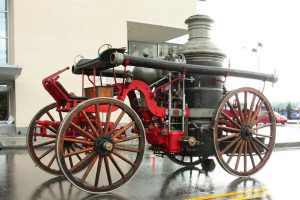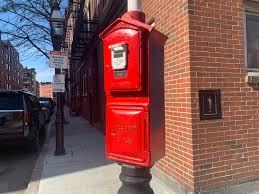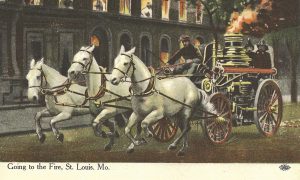March 20, 2025, marked the 120th anniversary of the catastrophic steam boiler explosion at the R.B. Grover Shoe Factory that is central to the plot of my new release, The Undercover Heiress of Brockton. My hero, Leo Eriksson, is a second-generation firefighter. His father and brothers are also firemen stationed together at the Campello firehouse, historically located on the same block as the ill-fated shoe factory.
Making one of main characters an early 20th century firefighter meant researching a profession I had little knowledge about. And boy, did I learn a lot. Unfortunately, several chapters which showed my firefighter hero and his fellow firemen battling another blaze had to be cut from the book. So, I hope you’ll put on your history nerd girl hat as I share some of what I learned.
Around the turn of the 20th century, rubber became part of standard firefighting gear. A long woolen coat provided the first layer of heat protection. This was covered with a heavy rubber slicker which provided a waterproof covering. Rubber also replaced leather as the first choice for footwear. Respirator gear was minimal, with most firefighters covering their mouth with a wet bandana or handkerchief to help filter smoke from their lungs.
About the same time, mechanized vehicles arrived in some big city fire departments. Smaller departments, like the one featured in The Undercover Heiress of Brockton, still used horses to pull steam-powered pumps for water. Ironically, the steam engine was designed to use fire to fight fire. The advancement from hand pumpers to steam pumpers was about a 300 gallon per minute difference that played a huge role in saving both lives and property.
But in order to be effective, the water had to be hot enough to produce steam. While in the fire station, the steamer tank was connected to a pipe in the firehouse that kept the water in tank warm. When the alarm came in, the fireman would start a fire under the boiler using coals, wood kindling, and a kerosene soaked rag that would bring the water from warm to steam level by the time the fire steamer engine arrived at the disaster.
The deleted scenes from The Undercover Heiress of Brockton were set in the upper-class neighborhood of Beacon Hill in Boston where the heroine was attending a dinner party at the home of childhood friends. Leo had agreed to volunteer with the Engine Company No. 3 serving Beacon Hill in order to learn about some of the modern equipment and techniques available to the city fire departments like those in Boston.
When a fire breaks out on the same street as the dinner party, an alarm box used to notify the fire department. Fire alarm boxes were installed in Boston beginning in 1852, over two decades before the first telephone patent. Boston was the first city in the world to use the telegraph as part of a municipal fire alarm warning system.
Each fire alarm box has a unique identification number. When the white lever is pulled, it sends an alarm to the Fire Alarm Office with the number of the box. The emergency responders who received the alarm then look up the address of the box and send the closest available fire trucks to the spot. Boston has around 3,500 fire alarm boxes spread out around the city which are often overlooked by passersby, but these red alarm boxes are still fully functional. In fact, just recently one resourceful citizen used the alarm box to notify the fire department when a fire broke out in a laundromat in the North End of Boston when the city’s 911 system had gone down.
Once the station received a signal of a fire in progress they needed to respond quickly. The firemen relied on trained firehouse dogs, typically Dalmatians, to snap into action. Dalmatians protective nature and reputation for bonding with horses, led them to be an ideal choice for this job. The dogs would herd horses from their stalls in the firehouse and position them below their harness which firemen would lower using a system of pulleys. Then the dogs would dart through the large firehouse doors and clear the exit of oncoming foot and mobile traffic from wagons or automobiles.
Beginning in November, new newsletter subscribers will receive the deleted scenes when they sign up for my monthly newsletter. (Don’t worry, current newsletter subscribers will automatically get them in your inbox.)




